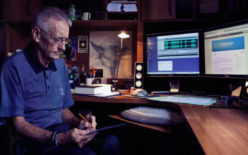While working on a Delta 1989 article it became apparent that a tutorial is in order concerning the NEADS primary source information of the day. Fragmented attempts to describe events using something other than what the intelligence community calls “all source analysis” are prone to error, if not outright failure. The same can be said for FAA tapes and transcripts, by the way.
The complete set of information needed to attempt any analysis of events in real time includes the radar files and the software to run them, time-stamped tapes, and any transcripts that were made. It is possible to overcome the lack of a transcript by making your own. In this article we will focus on NEADS tapes and transcripts and the 84th RADES radar files. A helpful start is to recount events from a Commission perspective.
The Commission Experience
Early DoD document requests surfaced the RADES files and software and a partial NEADS transcript, the only transcript prepared by NEADS after the events of 9-11. We understood that on the first trip to NEADS the organization would make tapes available. When we arrived NEADS was in the process of making digital files and they were fed to us piecemeal as we began the interview process. It quickly become clear that the partial transcript and provision of piecemeal tapes was not sufficient; we terminated the visit and caused DoD to be subpoenaed for all relevant files.
DoD provided the audio files but none of them had been transcribed. The Commission Staff determined that the best way to proceed was to farm the audio files out to professional transcribing organizations. One organization, Alderson Reporting, found the audio to be so confusing as to who was speaking that they opted to identify speaking voices and try and provide continuity of conversation on that basis. In practical terms than means that no Alderson transcript is time continuous, although Alderson did insert time benchmarks to assist the reader. The transcripts are helpful, but it takes “all soure analysis” techniques to get at the underlying events.
The technique the Staff used was to listen to the recordings using Adobe Audition so that individual conversations and transmissions could be accurately time stamped. Alderson was careful to provide a NEADS-recorded time stamp in each of its transcriptions. Concurrently, the Staff used the RADES RS3 software to display the radar files relevant to each transcript and tape. In sum, it took then, and it takes now, all three techniques–transcript, tape, and radar–to understand the events of the day as they occurred.
A Specific Example
Currently, for the Delta 1989 article, I am reading the Alderson transcript for NEADS position DRM 1, Channel 19 SD2 OP, the channel for Major Anderson, as depicted on a schematic of who was at what position. This is where Adobe Audition comes in handy. It is clear that the recording on the tape is not continuous, although the tape itself is. Nor is the transcript continuous. And the obvious question is why does that come about?
There are two reasons. First, because of the voice identification methodology, Alderson grouped together conversational fragments as if they cohered in real time, time gaps were simply omitted. The duration of the gaps, some in minutes not seconds, can be determined using a program such as Adobe Audtion.
Second, Major Anderson was free to move about and plug into any given console, as needed. When he unplugged from his primarly console there was no recording on the corresponding channel. For example, just before 9:31 (1:00:02 tape run time) a voice asked, “Major Anderson, you got a second?” And sure enough, Major Anderson unplugged and the recording stopped.
Moreover, certain members of the crew, Major Fox, for example, were free to plug in anywhere they needed. So, there is no specific channel for Major Fox, but his voice is heard throughout most tapes in at least background. Further, the MCC, Major Nasypany, was free to “camp” on any channel he wanted to, so his voice is also heard on many tapes. Even more confusing is that the three DRM “bled over” to each other during the copying process.
The net result on most NEADS tapes is a confusing blend of voices, background and foreground across the four main centers of activity–Surveillance, Identification, Weapons/Senior Director, and MCC. So, researchers must take the time to become familiar with the SOCC layout, the participant voices, the radar picture, and the tactical situation at any given time. Concerning the latter, it is also important to not impose post-facto awareness and understanding on facto (and pre-facto) conditions.
A few specifics from the SD2 transcript and tape (times rounded)
9:14: NEADS to Langley asking how many aircraft they can sortie
9:23: An American Airliner (3d aircraft headed toward Washington)
9:24: Scramble order heard in background
9:28: American 11 mentioned
9:42: Delta what?
9:55: Over Lake Erie
10:07: MCC we got an air track…over the White House [radar needed here]
10:09: ID type and tail
10:14: Washington [Center] was reporting our guys…no aircraft over Washington
To be continued
I will add to and refine this article as I relearn more of what I thought I knew 5 years ago.

One thought on “9-11: NEADS tapes and trancripts; a tutorial”
Comments are closed.